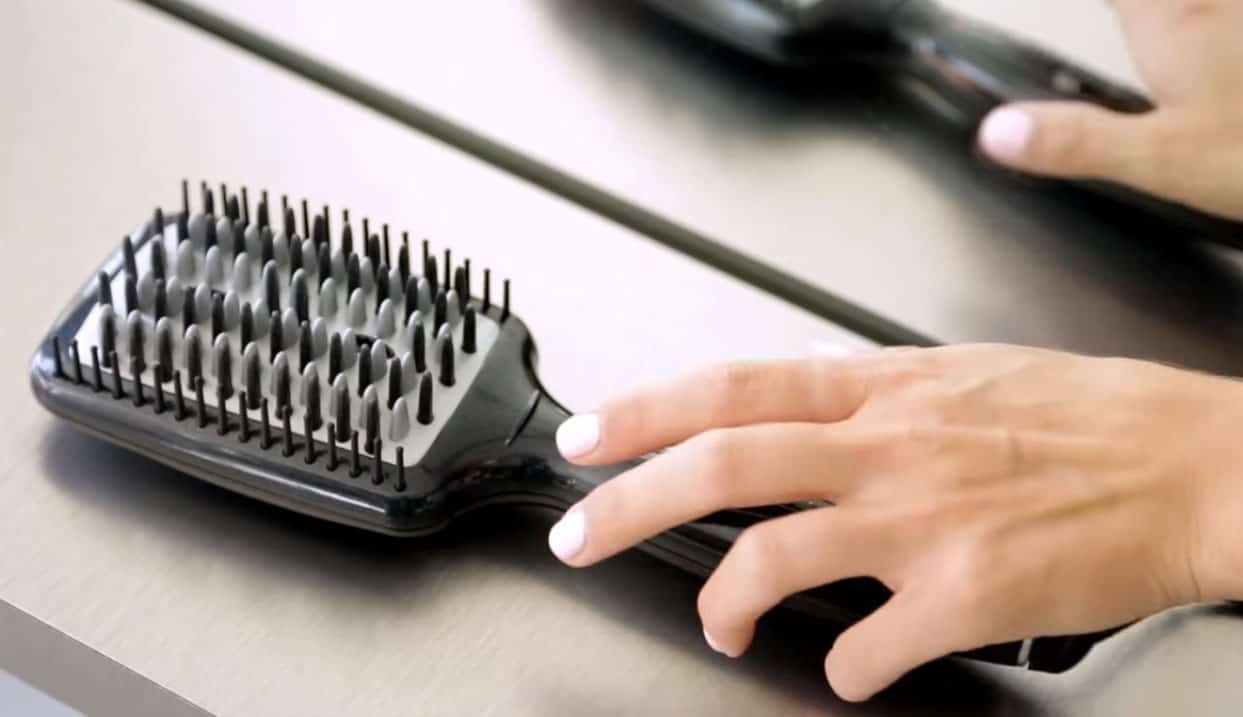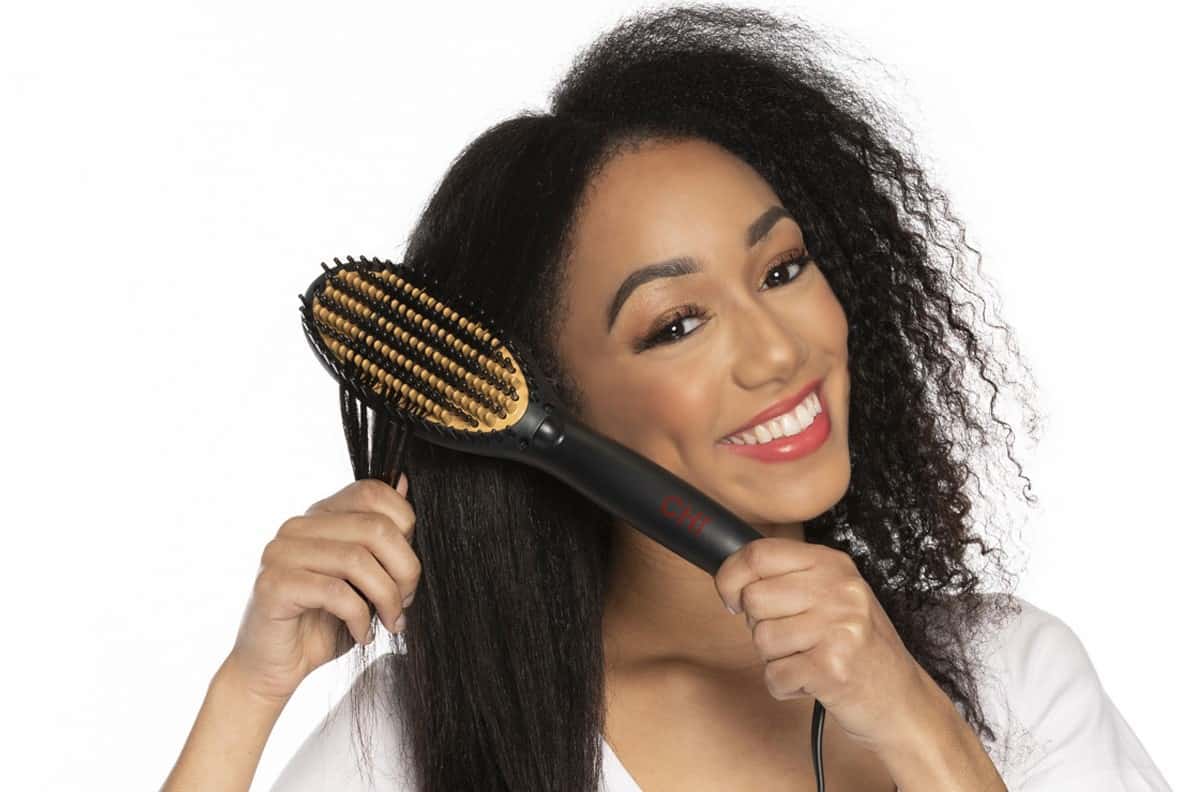Straightening brushes are becoming a real trend these days because they are so easy to use and less damaging to the hair. When you think about it, they are the perfect option for people who love straightening their hair on a daily basis. However, to keep them working properly and to keep your hair looking smooth and shiny, you have to keep the brushes clean. So today, I will tell you everything you need to know about how to clean your straightening brush!
Let’s be honest: We all leave our hot tools dirty sometimes. I am guilty of that myself, and I have to admit that until recently, I did not really understand why cleaning my hot tools was so important. It turns out that no matter how often you use your hot tools, you have to clean them if you want them to work to the best of their ability.
If you are someone who uses a lot of hair products, you might be unintentionally ruining your straightening brush by not cleaning it after using it. The product transfers from the hair to the brush and there are hair strands that get stuck as well. All of that combined can lead to bacteria and infections. The next time you use your hot tool, it will not only damage your hair, but it will also infect your scalp and maybe even your skin.
You and I both know that infections and bacteria are things that we would rather stay away from, but to do that, you need to know how to properly clean your straightening brush and all your other hot tools as well!
In this guide, I will cover everything you need to know about straightening brushes, including how to clean it, how often to go about it, and what to use. By the end of this guide, you will feel like a real cleaning pro thanks to all of my friendly tips!
Table of Contents
Why Do You Need to Clean Your Straightening Brush?
A lot of people think that cleaning their straightening brush is a waste of time – their hair is always clean and washed and after using the straightening brush they store it neatly, so there is no possible way for it to get that dirty. Well, I am here to tell you that this is not really the case.
Your hair has natural oils in it as well as residue from the hair products that you use, like hair sprays, masks, leave-in conditioners, and so on. Even when you think that your hair is completely clean, there might still be some product that can get transferred to the straightening brush when you use it.
On top of that, straightening brushes can sometimes pull on your hair. All of those hair strands you see in between the bristles can lead to the tool not working properly the next time you use it. The hair and residue will cause damage to your hair and also cause the tool to malfunction.
If you do not clean your straightening brush, chances are that you will need to buy new ones all the time since the old ones will stop working. Instead of investing all that money on new brushes, you can invest a few minutes of your time to clean your brush and make it work as if it was brand new!
How Often Do You Need to Clean a Straightening Brush?
How often your straightening brush needs cleaning mainly depends on how often you actually use it. If you are something like me and you want to straighten your hair every time you wash it, chances are that you will need to clean the brush more often. However, if you are not keen on straightening your hair and you only do it occasionally, you will not need to do thorough cleanups of the brush that often.
It is a good idea to give the brush a small cleanup every time you use it. What I mean by a small cleanup is not really getting into it and being thorough, but still removing most of the hair and buildup that might be forming.
On the other hand, you can thoroughly clean your straightening brush once every week or two depending on how often you use it. It will only take a few minutes, and I am pretty sure you have the supplies at home so you will not need to spend any money on it. But I will talk about this thorough cleaning more in the next section!
How Do You Clean a Straightening Brush?
Straightening brushes are not that different from flat irons when you think about it. So the cleaning of a straightening brush is not going to be that different compared to the cleaning of a flat iron.
There are a few simple steps that will make your straightening brush spotless and get it working as it did when you first bought it. For the cleaning process, you will only need a fiber cloth, some lukewarm water, or some cleaning solution, but I am going to recommend using water only, some alcohol, some cotton swabs, and maybe a smaller regular comb that will only be used as a helping hand. Now that I have covered all that, let’s get to the step-by-step guide!
Step 1 – Make Sure Your Straightening Brush Is Unplugged
I would recommend that you do the cleaning of the brush after using it. This means that once you are finished with styling your hair, you turn it off and unplug it, then leave it to cool down.
Wait for a few minutes, and then check to see if the brush has cooled down enough. You do not want to start cleaning too early as the brush can actually burn your hands!
Step 2 – Remove Tangled Hair
When you look at your brush, there is a good chance that you will see a lot of hair strands tangled in your brush bristles. Using the smaller comb, untangle and remove all the strands before you move on to the next steps. If you’d like, you can also use your fingers to get this step done.
Step 3 – Wipe the Brush
I recommend using a soft fiber cloth for the cleaning because it will not leave any fluffs on your brush. I also recommend only using water for cleaning (or maybe some alcohol). You do not need to spend any extra money on cleaning solutions as they can cause damage to the brush bristles, and you do not want to do that!
Use just a tiny bit of rubbing alcohol in a bowl of water and mix that up. Dip the cloth into the water, and then wipe the brush thoroughly. If there are any smaller parts that you cannot reach with the cloth, you can use some damp cotton swabs to clean them.
Make sure you are very thorough with this step – any buildup that you leave behind will damage your hair and the brush as well. So really get into the brush with the cloth and make sure everything is clean before moving on to the next step.
Step 4 – Dry the Brush
Now that the brush is all clean, I would recommend leaving it to air-dry or using a clean, dry cloth to wipe over it. You do not want to use it as long as it is still wet, so make sure that you do the cleaning only when you do not actually need to use the brush.
Step 5 – Your Brush Is All Clean!
Once the brush is clean and dry, you can store it away and keep it clean until the next time you need to use it. It might be a good idea to find a box or bag to store the brush in so that it does not get covered with dust right away.
Remember to repeat these few cleaning steps at least two times a month in order to make the most of your cleaning brush. Trust me, your hair and your wallet will benefit from it in the long run!
What Do You Clean a Straightening Brush with?
Before you actually start cleaning your straightening brush, it might be a good idea to go over your manual and see what the manufacturing company recommends for your specific type of brush. You could go over a ton of guides on the internet and read a lot of things about this and that kind of solution, but in the end, it might damage the brush. The safest bet would be to check the manual and then go about cleaning in the recommended way.
I would like to mention that some people like using cleaning solutions or shampoos to clean straightening brushes, and even though they are very effective in some cases, I do not recommend them. They can sometimes contain ingredients that are too harsh, and they may damage the bristles or the electricals, leading to the brush not working properly.
I would suggest going another way and using lukewarm water to clean your straightening brush. You can add a couple of drops of rubbing alcohol, but do not go overboard with it (even if your brush is very filthy). With regular and thorough cleaning, you will remove all that dirt and build-up before you know it!
FAQs on Cleaning Straightening Brushes
If you have read this far, you should have a clear idea of how to clean your straightening brush and what to use. Before I let you go to clean your brush, I would like to also share with you some questions that other people have asked on this topic. So let’s see the frequently asked questions on cleaning hairbrushes!
How do you dissolve hair from a brush?
You can dissolve hair from a brush using a number of different cleaning solutions, but when it comes to this kind of brush, I would not recommend trying any of those solutions. It is a better idea to be safe. This means it is best to remove the hair using your fingers or another comb, as I mentioned earlier.
Is a straightening brush worth it?
My answer to this is yes, straightening brushes are definitely worth it. Even though some people might not find them effective or easy to use, I have loved using a straightening brushes for my hair, especially the ones from L’ange and Head Kandy.
With that being said, my hair is more on the fine side, so I do not have a problem straightening it at all. However, if you have curlier or thicker hair, you will have some problems using a brush to straighten it. I would suggest dividing it into sections and setting the brush to a high temperature so that you get the most from the straightening!
That Is All You Need to Know About Cleaning Straightening Brushes!
Thank you for sticking with me through this detailed guide on how to clean hair straightening brushes quickly and effectively. If you follow my advice, you should make your brush spotless in only a matter of minutes, and it will work like a charm from there on out.
Remember that cleaning a straightening brush (or any other type of hair tool) is not a one-time thing. You need to clean your hair tools at least a couple of times a month, and when you do it, make sure to be careful, gentle, and very thorough.
Let me know if you have any other ideas on cleaning straightening brushes or what to use in the process. I look forward to reading your comments!
0



